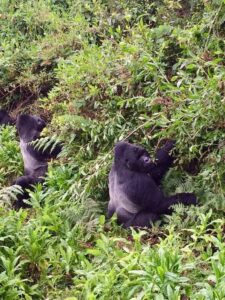Gorillas are gentle giants, herbivorous in nature and predominant ground-dwelling great apes displaying many human-like behaviors, they can laugh, grieve, have rich emotional lives, develop strong family bonds, make and use tools, and think about the past and future. They are considered highly intelligent that they share 98.3% of their genetic code with humans, making them our closet cousins after chimpanzee and bonobos. They are the largest of the great apes/ living primates.

They are stocky animals with broad chest and shoulders, large reaching heights between 1.25 and 1.5 meters, weigh between 100 and 270Kgs with human like hands up to 2.6metres depending on the species and sex with small eyes set into hairless faces. The gorillas are divided into two species, the eastern and the western gorilla living in equatorial Africa, which is spread by 560 miles of Congo basin forest and each has a lowland and upland subspecies.
Gorillas live in family groups of usually 5 to 10 led by a dominate adult gorilla known as a silverback who holds this position for years. Females become sexually mature around seven or eight years old but don’t begin breeding until a couple of years later. Like humans, gorilla reproduce slowly. Giving birth to only one baby at a time and then raising that infant for several years before giving birth. These gentle giants tend to live 35-40 years in the wild.
CHARACTERISTICS OF GORILLAS.
Wild male gorillas weigh 136kg while adult females weigh 68-113kg. Adult males are 1.4 to 1.8 m ( 4 ft 7 to 5 ft 11 ) tall with an arm span that stretches from 2.3 to2.6 m (7 ft 7 in to 8 ft 6 in ) while female gorillas are shorter at 1.25 to 1.5 m(4 ft 1 in to 4ft 11 in) with smaller arm spans.
The eastern gorilla is more darkly than the western gorilla whereas the mountain gorilla being the darkest of all. The mountain gorilla has the thickest hair while the western lowland are brown or greyish with a reddish forehead. The eastern gorilla has a longer face and broader chest than western gorillas.

Gorillas move around by knuckle-walking but at times they move upright for short distances for example when carrying food or in a defensive state. Like humans, gorillas have individual fingerprints, their eyes are dark brown in color, framed by a black ring around the iris.
A gorilla`s lifespan normally last for about 35-40 years though zoo gorillas may live longer up to 50 years or more.
When it comes to diet and foraging, a gorilla`s day is divided between rest, travel or feeding period. Their diet differ within the species, mountain gorilla eat foliage in most cases such as leaves, pith, stems, shoots etc. whereas fruits make a small part of the diet. The eastern lowland gorillas a lot more diets which very seasonally, Leaves and pith are commonly eaten though fruits make up 25% of their diets. The eastern lowland gorillas also depend on insects mostly ants. The western lowland depend on fruits though termites and ants are eaten.
Gorillas unlike other primates live in nests, they construct nests for daytime and night use and these nests are made out of tree branches and leaves in a simple aggregated manner. The most interesting thing about these gentle giant creatures is they make new nests to sleep in daily, do not use the previous one.
These creatures live in groups called troops and these troops are led by an adult male or a silverback with a harem of multiple adult females and their offspring. A silverback is typically more than 12 years of age and it’s named for the distinctive patch of silver hair on its back which comes with maturity. They also have large canine teeth which also comes with maturity.
The responsibility of a silverback in the troop is to make decision, handling conflicts, leading others to feeding sites, determining group movement, being responsible for safety and wellbeing in the troops. Male gorillas stay in their natal troops and become subordinates to the silverback, young males known as black backs serve as backup protection.
The bond between a silverback with his females forms the core of gorilla social life. Female gorillas mature at the age of 10-12 years, they will pursue their lips and slowly approach a male while making eye contact and this signals the male that it wants to be mounted and if the male doesn’t respond then she will try to attract his attention by reaching towards him or slapping the ground. Their first ovulatory cycle occurs when she is six years of age, followed by two year period of adolescent and they first give birth at 10 years of age. Its gestation period lasts for 8.5 months.
When it comes to communication, gorilla sounds are classified as grunts and barks. These sound indicate the whereabouts of individual group members, used for social interactions when discipline is required, screams and roars signal alarm or warning and these sounds are mostly produced by silverbacks where as deep, rumbling belches suggest contentment and heard during feeding and resting periods.
Scientific Classification
- Kingdom: Animalia
- Phylum: Chordate
- Class: Mammalia
- Order: Primates
- Family: Hominidae
- Tribe: Gorillini
- Genus: Gorilla
- Lifespan: 35-40 years
- Gestation period: 257 days
- Feeding: Herbivorous










 You cannot copy content of this page
You cannot copy content of this page